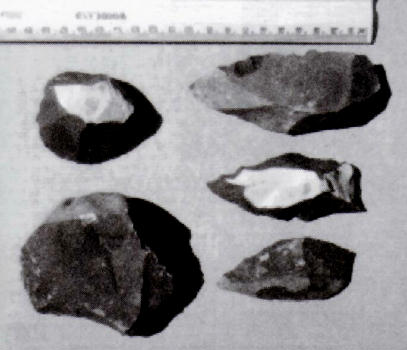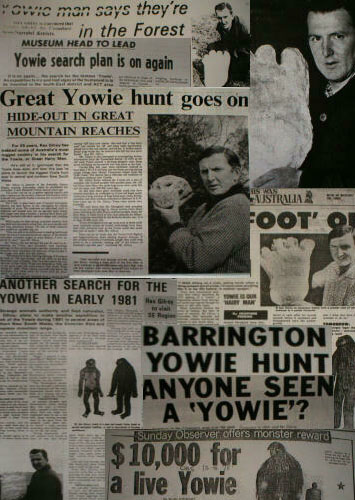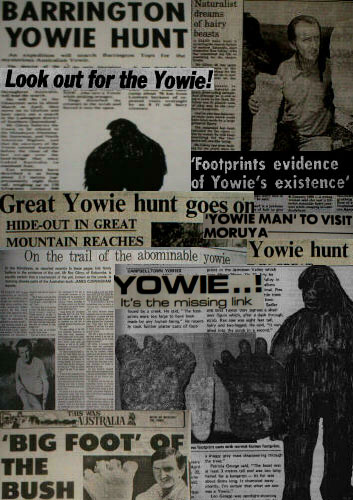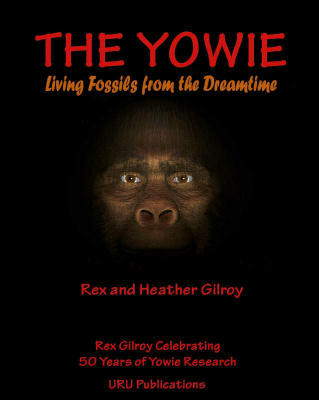Homo erectus and the Pygmies
This article is composed of extracts from the 2007 book:
“The Yowie Mystery - Living Fossils From The Dreamtime".Copyright (c) 2007 Rex Gilroy, Uru Publications.
It appears quite evident to the authors from the fossil evidence gathered by us, that there is a continuing evolutionary progression, beginning perhaps around 17 million years ago with a race of primitive ancestral hominids, through to the beginning of the Pliocene, and finally around the end of that era into the Pleistocene with the appearance of proto-Homo erectus and his later Homo erectus offshoot, culminating in Homo sapiens by at least 400,000 -300,000 years ago.
Somewhere along the way in the course of this evolutionary progression there were genetic mutations.
These mutations saw the appearance of giant hominid forms as already stated in the previous chapter and also pygmy forms.
Photo Left: Five small, recently manufactured forest pygmy stone tools, found at a remote site deep in the Lamington Plateau rainforests, southern Queensland by Rex Gilroy. Photo copyright © Rex Gilroy 2007.
When exactly these evolutionary offshoots developed remains a mystery to scientists, so their timing at our present knowledge is open to speculation. We would here remind the reader that we are speaking of fossil evidence recovered in Australia and not Asia or Africa and therefore the evidence presented by us remains highly controversial and not ‘politically correct’. Yet our theory we believe, in the current climate of speculation, based as it is upon the interpretation of the fossil evidence at our disposal, should be treated as yet another alternative explanation of the giant and pygmy evolutionary problem.
Palaeoanthropological finds made in Africa have long ago shown that our hominid ancestors were small in stature to begin with. ‘Lucy’ discovered in Ethiopia in 1974 by Donald C. Johansson was no more than 3½ ft [1.7m] in height. Lucy, an Australopithecine lived around 3.4 million years ago, while the Bega district New South Wales skull endocast is of a being no more than 1 – 1.1m in height who lived 7 million years ago. There is no relationship between the two discoveries as Australopithecus was confined to Africa, unless some future scientific discovery proves otherwise. All that can be said of the Bega district fossil at present is that it is an ancestral form on the way to Homo erectus.
The authors have found a number of fossil footprint sites dating from Pliocene times, containing both giant-size and modern human-size tracks, including child-size examples, whether these later specimens are those of juveniles or pygmy hominids remains unestablished; although the presence of giant hominid tracks in Pliocene deposits clearly shows that these beings had evolved from the ancestral hominid line by this time. It is also possible that, while some groups of the small ancestral hominids began to increase in height, others for one genetic reason or another did not, thus forming the earliest pygmy Homo line.
The available fossil skeletal evidence of giant hominids found by us, already described in the previous chapter, so far only dates from the later part of the Pleistocene period and displays Homo erectus relationships. Our pygmy Homo fossil evidence on the other hand, suggests that. apart from possible beginnings some time in the Pliocene, the Pygmy Homo line was well established by early Pleistocene times with the fossil evidence showing that more than one race is present in the fossil record.
This chapter concerns itself with the fossil evidence for a Pygmy evolution in Australia, separate to that of African pygmies. Anthropologists recognise that the Pygmy has a considerable antiquity in Africa, whereas in Australia our scientists have only ever recognised one form, namely pygmy Australoids of the Far North Queensland rainforests, which they believe are related to the former Tasmanian Australoids whose features they shared, although the later people were slightly taller.
As the traditions of our Aboriginal people will show later in this book, the early tribespeople recognised a number of pygmy races throughout the continent, which they collectively designated as the “little hairy people”, once again as with the taller Homo erectus/Yowie, they were described as ‘hairy’ due to the animal hide cloaks they wore... Photograph right: Aboriginal Girl wearing a Kangaroo hide Garment. Photographer Unknown. I will credit anyone who owns this photograph.
The available Gilroy pygmy fossil skeletal evidence consists of, in the first case, a mineralised ironstone mummified head recovered by Mrs Joy Colley on her farm property outside Oberon to the west of the Blue Mountains and in the second, a mineralised limestone endocast unearthed by the Gilroys near Maryborough, Queensland. These two specimens indicate that this particular pygmy race was considerably widespread, at least between Queensland and New South Wales at a very remote period.
The first of these specimens, the mummified head, was found by Mrs Joy Colley one day in 1995 as she was walking along a narrow sheep track on a hillside, in a gully below her farmhouse. Being a ‘rockhound’ she had been keeping an eye out for good specimens and when she spotted what she thought was an unusually shaped lump of ironstone, she picked it up. Once back at the farmhouse she placed the ‘lump’ on a shelf. Some time later she happened to have a closer look at it and realised its likeness to a little human face. Eventually she came into contact with Heather and I, and gave us the specimen. It was then that I was able to tell her that she had indeed found a human fossil, a mummified head with some skin still attached to it.
In the light of the so-called ‘Hobbits’ skeletal remains recently excavated on the Indonesian island of Flores, dating a mere 18,000 years, we cannot help wondering if they might not have originally had an Australian origin! So, if these two skull-types appear so ‘modern’ where should they be placed in the pygmy line-up? It is obvious that more fossil skull material is needed of this particular little race and I believe that older related ‘archaic’ fossil skull-types of this people, which hopefully will turn up eventually, will show their evolutionary link to Homo erectus in very early Pleistocene times.
Homo erectus skulls found worldwide display considerable variation. They reveal that there were a number of Homo erectus racial types, and this would no doubt have been carried on by the giant and pygmy races which developed from him. The actual origins of the pygmies worldwide; principally those of Africa, the Andaman Islanders, the Semang of the Malay peninsula, and the Philippines Negritos remains one of the most controversial, even enigmatic subjects in the field of human taxonomy. And to this list must be added pygmy groups to be found throughout Melanesia, Australia and its island state of Tasmania.
In the last case the now totally extinct [full-blood] Aboriginal population, once referred to as being pygmy-like were in fact not small enough to belong to the true pygmy class, but were actually smallish Australoids. Similarly, the pygmy folk of the Cape York-Atherton jungles of Queensland’s far north have long ago been identified as another Australoid group, whose smallish stature and crinkly Negroid-like hair is explained as being the result of living in their darkened forest environment. However, as this book reveals, there are other pygmy folk of more than one type inhabiting Australia, but which remain unrecognised by the scientific establishment. Even New Zealand was once host to a mysterious little pygmy folk, if old Maori traditions are to be accepted, as the authors believe they should.
“The Yowie Mystery - Living Fossils From The Dreamtime".
“The Yowie Mystery - Living Fossils From The Dreamtime". Special Dedication. The Authors dedicate this book to the late Charles Melbourne Ward F.Z.S.; F.R.Z.S. known to his great many friends simply as ‘Mel’. Together with his wife Halley, he operated a natural history museum in the grounds of the Hydro Majestic Hotel at Medlow Bath for many years and also another established at Echo Point, Katoomba. It was ‘Mel’ who first taught me how to collect, record and study natural history specimens, beginning when I was aged 11 years old on holidays with my parents at Katoomba in 1954. Thereafter, every school holidays spent in Katoomba began with a visit to ‘Mel’ at his Medlow Bath Museum to inform him how my fledgling natural science studies were progressing!
As a result and after my parents moved from our Lansvale [western Sydney] home to Katoomba, the Gilroys and Wards became close friends. There was hardly a week which did not see me peddling my pushbike from our North Katoomba home up the Great Western Highway to see ‘Mel’ at his museum for more instruction. Mel Ward possessed a wide knowledge of the culture of the Australian Aborigines and that of the former local Blue Mountains tribes in particular.
He was also a firm believer in the “Hairy Man” and supported my researches in this regard. At my 21st birthday party, held at the Homesdale Function Centre, at Katoomba on Saturday night 8th November 1964, I well recall how my old friend, in front of a large gathering, congratulated me on my researches and the large natural science collection that I was forming and then said: “You’ve done a fantastic job Rex, BUT IT’S ABOUT TIME THAT YOU STARTED MAKING SOME BLOODY MONEY OUT OF IT” in a loud voice that brought the house down!
That following week, together with my father Mr W.F. [Bill] Gilroy, I began a search of local venues, which soon resulted in the acquisition of the lease from the Blue Mountains City Council of the Mt York Tea Rooms, outside Mt Victoria, the rest they as “is history”. Two years late, on October 6th 1966, Mel Ward was dead, having passed away in his sleep. He once said to my father that I was “the Mel Ward of Tomorrow” and I am certain that Mel would be pleased to know that I have indeed followed in his footsteps.
Mel led an adventurous life. The son of Hugh J. Ward, a famous Shakespearean actor of the early 20th century, Mel was encouraged to go on the stage by his father but Mel developed a passion for the natural sciences and his wealthy parents helped him become established. In his lifetime of achievement, Mel became recognised as a world authority on Crustaceans and an anthropologist. He was made a Fellow of the Royal Zoological Society of New South Wales and was pleased when I too became a member of the Society in 1963. He encouraged me, not long before his death, to take on the Presidency of the Society’s Entomological section, where I served for three years from 1966 to 1969.
That he achieved so many things in the course of his lifetime researches is remarkable, because like this author, he was an amateur with not one university degree to his name! I am certain that my old friend would be delighted at the fact that, together with heather, I am now writing and publishing book on the subjects he loved and on the Yowie in particular. He taught me never to blindly follow the textbook and dare to question dogmas and not be told what to think! I have certainly followed his advice. Knowing Mel Ward as I did I know he would wholeheartedly approve of the scientific approach of this book, therefore “Mel”
This Book is for You!
Rex Gilroy - Australian Yowie Research Centre, Katoomba, NSW.
Monday 25th June 2007I also present sensible advice to any future would-be Yowie investigators. The reader will also be awed at the great many discoveries my wife Heather and I have made in all our years together in the field. I feel privileged to be the founder of Yowie research and to have encouraged other, sensible researchers to follow my example. The search for surviving relict hominids in remote, hidden regions of the world, has been called the “last great search”, and it is both a fascinating and exciting one. Rex Gilroy may be contacted at the Australalian Yowie Research Centre, PO Box 202, Katoomba. NSW 2780. Ph 02 4782 3441 or email New Email Address as of June 2009 randhgilroy44@bigpond.com on or visit our website : http://www.mysteriousaustralia.com/ or http://www.australianyowieresearchcentre.com/ or http://www.rexgilroy.com/
Newspaper Articles on Rex Gilroy's Lifetime Search for the Australian Yowie
Newspaper Articles on Rex Gilroy's Lifetime Search for the Australian Yowie
Aboriginal/Koori Names for the Australian Yowie
To present the Yowie mystery in its proper context, relict hominid evidence from south-east Asia, New Guinea, other west Pacific Islands and New Zealand is revealed, demonstrating how the ancestors of these ‘manimals’ once spread out across the earth via land-bridges that formerly joined Australia/New Guinea/New Zealand with what is now island south-east Asia to the Asian mainland.
“Hairy man” was a name given by the Aborigines to any non-Aboriginal race with which they shared this continent, but the term centred primarily upon at least three basic forms. These forms were either the height of an average human being, an enormous man-like and also ape-like form. All were known by different names Australia-wide, but all meant either “hairy man” or “great hairy man”.






